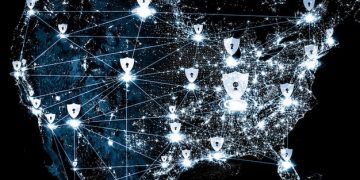Emerging Cybersecurity Threats: Ransomware Tactics Targeting Small Businesses in 2025

Cybersecurity threats, particularly **emerging ransomware tactics targeting small businesses in 2025**, involve sophisticated techniques like AI-driven attacks, cloud-based ransomware, and supply chain exploitation, necessitating advanced defense strategies and proactive security measures for SMBs.
Small businesses face an increasingly complex and dangerous cybersecurity landscape. Understanding the **emerging ransomware tactics targeting small businesses in 2025** is crucial for survival in the digital age.
Understanding the Evolving Ransomware Landscape
The ransomware landscape is constantly evolving, with new tactics and techniques emerging all the time. It’s essential for small businesses to understand this landscape to protect themselves effectively.
Ransomware attacks are becoming more sophisticated, leveraging advancements in technology like artificial intelligence and cloud computing. Understanding these changes is the first step toward building a more resilient defense.
The Rise of AI-Powered Ransomware
AI is now being used to automate and personalize ransomware attacks, making them more effective and harder to detect. Cybercriminals are leveraging AI to identify vulnerabilities, craft convincing phishing emails, and even negotiate ransom demands.
Cloud-Based Ransomware
As more small businesses move their data and operations to the cloud, ransomware attacks are also targeting cloud environments. These attacks exploit misconfigurations and vulnerabilities in cloud infrastructure to encrypt data and demand ransom.
- Increased Automation: AI streamlines the attack process, allowing for faster and more efficient deployment.
- Enhanced Targeting: AI can analyze data to identify high-value targets and tailor attacks accordingly.
- Evasion Techniques: AI can help ransomware evade detection by learning from past attacks and adapting its behavior.
The evolution of ransomware underscores the importance of staying informed and adapting security measures accordingly.
Specific Ransomware Tactics to Watch Out For
Beyond the broader trends, several specific ransomware tactics are expected to pose a significant threat to small businesses in 2025.
These tactics often exploit common vulnerabilities and human error, making it critical for SMBs to address these weaknesses proactively.
Double Extortion
Double extortion involves not only encrypting data but also stealing it and threatening to release it publicly if the ransom is not paid. This tactic puts additional pressure on victims to comply with demands.
Ransomware-as-a-Service (RaaS)
RaaS platforms make it easier for individuals with limited technical skills to launch ransomware attacks. These platforms provide all the tools and infrastructure needed to carry out an attack, lowering the barrier to entry for cybercriminals.

- Data Exfiltration: Prioritizing data protection and implementing robust access controls to minimize the risk of data theft.
- Public Shaming: Understanding the potential reputational damage of data breaches and implementing incident response plans to mitigate the impact.
- Affiliate Programs: Recognizing that RaaS attacks can be carried out by a wide range of individuals, increasing the potential attack surface.
Being aware of these specific tactics can help small businesses better prepare for and respond to ransomware attacks.
Strengthening Defenses: Key Security Measures for SMBs
Protecting against ransomware requires a multi-layered approach that addresses both technical and human factors. Small businesses need to implement robust security measures to minimize their risk.
These measures should be tailored to the specific needs and resources of the business, focusing on the most critical vulnerabilities and assets.
Employee Training and Awareness
Employees are often the first line of defense against ransomware attacks. Regular training and awareness programs can help them identify and avoid phishing emails and other social engineering tactics.
Regular Data Backups
Regularly backing up data is essential for recovering from a ransomware attack without paying the ransom. Backups should be stored offline and tested regularly to ensure they are working properly.
Employee training and robust data backup strategies form the cornerstones of effective ransomware defense.
Advanced Technologies for Ransomware Prevention
In addition to basic security measures, small businesses should also consider implementing advanced technologies to enhance their ransomware prevention capabilities.
These technologies can provide an extra layer of protection by detecting and blocking ransomware before it can cause damage.
- Endpoint Detection and Response (EDR): EDR solutions monitor endpoints for suspicious activity and automatically respond to threats.
- Security Information and Event Management (SIEM): SIEM systems collect and analyze security data from across the network to identify potential attacks.
- Threat Intelligence Feeds: Threat intelligence feeds provide up-to-date information on the latest ransomware threats and vulnerabilities.
Implementing EDR Solutions
EDR solutions can help detect and respond to ransomware attacks in real-time, minimizing the potential impact. They offer advanced capabilities like behavioral analysis and threat hunting.
Utilizing SIEM Systems
SIEM systems can provide a comprehensive view of the security landscape, helping to identify and respond to ransomware attacks more effectively. They can also help with compliance and reporting.
Investing in advanced security technologies can significantly improve a small business’s ability to prevent and respond to ransomware attacks.
Incident Response Planning: Preparing for the Inevitable
Even with the best security measures in place, there is always a risk of a successful ransomware attack. Small businesses need to have a well-defined incident response plan to minimize the damage.
This plan should outline the steps to take in the event of an attack, including containment, eradication, recovery, and post-incident analysis.

Developing a Comprehensive Plan
A comprehensive incident response plan should include clearly defined roles and responsibilities, as well as detailed procedures for each stage of the response process.
Regular Testing and Refinement
An incident response plan is only effective if it is regularly tested and refined. Conducting tabletop exercises and simulations can help identify weaknesses and improve the plan’s effectiveness.
A robust incident response plan can help small businesses quickly contain and recover from a ransomware attack, minimizing the disruption to their operations.
The Role of Insurance in Mitigating Ransomware Risks
Cyber insurance can help small businesses mitigate the financial risks associated with ransomware attacks. These policies can cover costs such as ransom payments, data recovery, and business interruption.
However, it’s important to carefully review the terms and conditions of the policy to ensure it provides adequate coverage.
- Coverage Options: Understanding the different types of coverage available, including ransom payments, data recovery costs, and business interruption losses.
- Policy Exclusions: Being aware of any exclusions in the policy that could limit coverage in the event of an attack.
- Due Diligence: Ensuring that the business has implemented adequate security measures to qualify for coverage.
Cyber insurance can provide a valuable safety net for small businesses facing the threat of ransomware attacks.
By staying informed, implementing robust security measures, and preparing for the worst, small businesses can significantly reduce their risk of becoming victims of ransomware.
| Key Point | Brief Description |
|---|---|
| 🤖 AI-Powered Attacks | AI automates and personalizes attacks, making them more effective. |
| ☁️ Cloud Ransomware | Attacks target cloud vulnerabilities and misconfigurations. |
| 💰 Double Extortion | Data is both encrypted and stolen for ransom. |
| 🛡️ Employee Training | Regular training helps employees identify and avoid phishing attacks. |
▼
Emerging ransomware includes AI-powered attacks, cloud-based ransomware, and Ransomware-as-a-Service (RaaS), each posing unique threats to small businesses.
▼
Small businesses can protect themselves by implementing advanced security solutions, employee training, and staying updated on the latest AI threat intelligence.
▼
A response plan should include detection, containment, eradication, recovery, and post-incident analysis, with clearly defined roles and responsibilities.
▼
Cyber insurance can cover costs like ransom payments, data recovery, and business interruption, but policies should be reviewed carefully for coverage details.
▼
EDR provides real-time endpoint monitoring and threat response, while SIEM offers comprehensive security data analysis, enhancing overall ransomware detection and prevention.
Conclusion
The threat of **emerging ransomware tactics targeting small businesses in 2025** is a serious concern that requires proactive measures. By understanding the evolving landscape, implementing robust security measures, and preparing for the worst, small businesses can protect themselves from the devastating impact of ransomware attacks.





